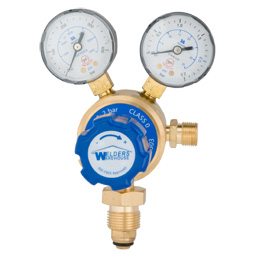01908 6998020845 899 4400 | 01908 699802Tel 01908 699802
Choosing Welding Gas Regulators
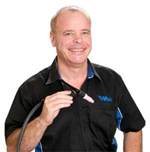

All compressed gases are dangerous, some more than others, so the correctly choosing Welding Gas Regulators is essential.
Gas Regulator Construction
Gas Regulators vary in construction, depending on the gas they’re intended for. Probably the most obvious difference is the screw threads.
Regulators for combustible gases (Acetylene, Propane, Propylene etc), usually have Left Hand Threads. The left hand thread is indicated by little cuts in the flats of the Hexagon.
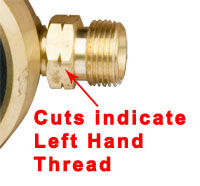
Regulators for non combustible gases (Oxygen, Argon, Co2 etc), usually have Right hand Threads and as such do not have the cuts on the Hexagon.
Another important difference can be the material used to manufacture internal components.
For example, internal Acetylene Regulator components are manufactured from different material to Propane Regulators. It’s therefore important that the correct regulator is used as failure to do so can be extremely dangerous.
In the example outlined above, Propane will corrode the internal components of an Acetylene Regulator, inevitably leading to failure and leaking!
So when choosing welding gas regulators, ALWAYS select the correct regulator for the gas!
Single Stage v Multi Stage Regulators
I’ve written a separate article on the Difference between Single and Multi Stage Regulators
I’ve also produced a Video
Oxygen Gas Regulators
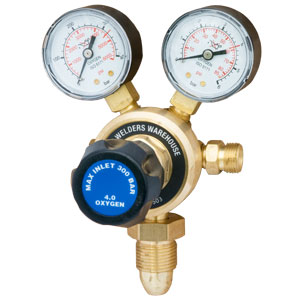
The most common type of Oxygen Regulator has a 0-10 bar outlet. However, as Gas Welding Torches typically only require around 0.2 bar, a Regulator capable of delivering up to 10 bar is going to be difficult to adjust accurately at such a low pressure.
To overcome this, 0-4 bar Oxygen Regulators are also available. These are much easier to adjust at the low pressures required for most Gas Welding & Brazing torches. Even Cutting Guns can be used with nozzles up to 1/16″.
0-10 bar are for where larger Nozzles are going to be used.
I would also recommend not considering an Oxygen or Argon regulator with less than a 300 bar input rating as 300 bar cylinders are becoming more common and are likely to become the norm in future.
Acetylene Gas Regulator
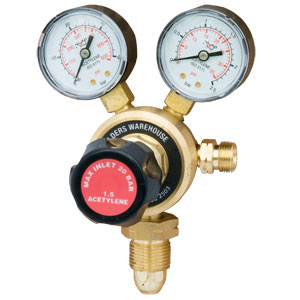
Acetylene becomes unstable and explosive if compressed to a high pressure. Because of this, Acetylene is dissolved in a special material.
Because of the low pressure nature of Acetylene cylinders, the Gas Regulator for Acetylene has a different internal set up.
Most Acetylene Regulators have a maximum delivery pressure of 1.5 bar.
Propane Gas Regulators
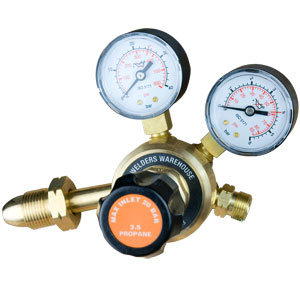
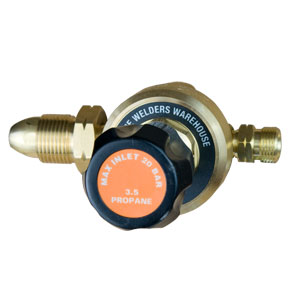
Propane Regulators are commonly supplied with, or without gauges.
As discussed earlier, Acetylene and Propane Regulators should never be used with any other gas than that which they are designed for, although Propane Regulators can be used for Propylene, which is made up of around 50% Propane.
Argon and Argon/Co2 Gas Regulator

Argon Gas Regulators are much the same as Oxygen Regulators. However, a key thing to look out for is the Delivery Gauge (usually on the Right).
On an Oxygen Regulator the delivery Gauge normally shows Pressure in Psi and Bar. Argon Regulators normally show Gas Flow Rate in Litres Per Minute and Cubic Feet Per Hour.
It’s important to make sure the Delivery Gauge reads Flow Rate as most Mig and Tig Welders will quote a recommended delivery in Litres per Minute.
An Argon Regulator should also be used for Argon/Co2 Mixed gases.
CO2 Gas Regulator

Most of a Co2 Regulator is the same as an Argon Regulator.
The one BIG difference is the Cylinder Fitting, which is Female.
All the other Regulators we have discussed have a Male thread to go into a Female Fitting on the cylinder. Co2 Cylinders have a Male thread, so the Regulator has to have a Female fitting.
Gas Regulators for Disposable Gas Cylinders
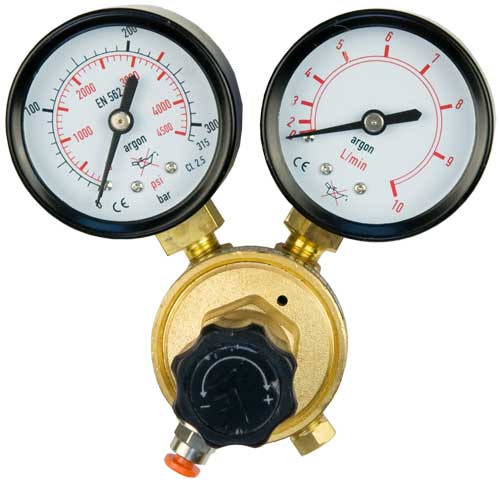
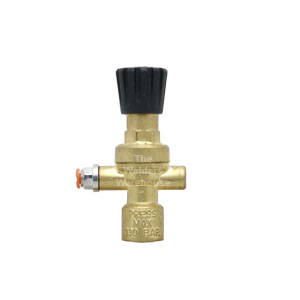
Regulators for Disposable Gas Cylinders do the same job as their refillable cylinder counterparts, except the fitting onto the Cylinder is completely different.
Disposable Cylinders are filled to a lower pressure.
For these reasons, Disposable Cylinder Regulators are not compatible with refillable cylinders.
Regulators for use with Disposable Cylinder can have no Gauges, 1 Gauge or 2 Gauges.
Conclusions
Correctly choosing welding gas regulators is important as pressurised gas cylinders can be dangerous.
But as long as care is taken to choose good quality and the right specification/type for the gas you’re going to be using, all should be well.
I hope you’ve found this article useful, you can find more Gas Equipment related information in our Knowledge Zone and in other articles of my blog.
Please let me know what you thought of this article by leaving a comment. Don’t worry, your email address won’t be added to a database or shared and you won’t receive any unsolicited email.
Cheers
Graham

Whats the difference between Single Stage and Multi Stage Regulators


As some of you may prefer to watch rather than read, I’ve also produced a VIDEO on this subject.
Single Stage Regulators
A Single Stage Regulator takes Cylinder Pressure and reduces it down to an adjustable pressure output.
For example, in the case of an Oxygen Cylinder, the cylinder pressure of up to 300 bar (4410 psi) is reduced in a single step to the output of 0-4 bar (for example).
The main advantage of a Single Stage Regulator is price. Simply put, they’re cheaper than Multi Stage Regulators.
The downside is Single Stage Regulators have a less stable output, especially at low pressure settings.
Where Single Stage Regulators are used for high output applications, it will be necessary to adjust the pressure from time to time. This is because as the cylinder pressure drops, the output pressure will creep up.
Multi Stage Regulators
A Multi Stage Regulator is a bit like having two Single Stage Regulators in one!
The first, non adjustable stage, reduces Cylinder Pressure to around 10 bar (can be up to 20 bar).
The adjustable 2nd stage is used to deliver the output pressure required by the operator.
This means when you adjust the Regulator, you are only dropping the pressure from between 10 or 20 bar to your desired output pressure. Not up to 300 bar down to desired output pressure!
Multi Stage Regulators offers two key advantages over Single Stage Regulators.
Multi Stage Regulator Output pressure is more stable.
Reducing cylinder pressure in 2 steps results in greater output pressure stability and consistency. Stable, Consistent output pressure is especially important where a very low pressure is required – very small flame torches for example.
Secondly, where high gas consumption is used, the delivery pressure is more consistent over the life of the cylinder. This is because as cylinder pressure drops, a Single Stage Regulator will gradually deliver a higher and higher gas pressure. This will necessitate regular adjustment to maintain delivery pressure.
A Multi Stage Regulator offers much more consistent output pressure because the depleting cylinder pressure has little effect on the adjustable second stage.
How to tell the difference between Single & Multi Stage Regulators
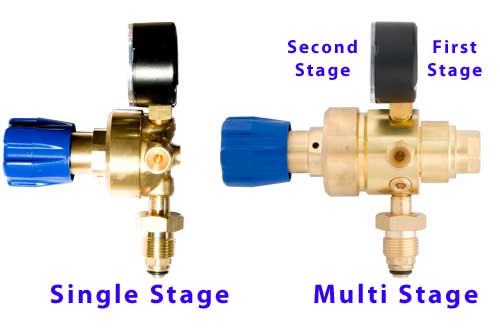
From the front, Single Stage and Multi Stage Regulators look very similar.
But you can see from the above image, a Multi Stage Regulator has the 1st Stage protruding from the rear. This is the most obvious visual difference between the two types!
Conclusions
If you need your Gas Regulators to be cheap, Single Stage Regulators are likely to be your best choice.
If consistency of delivery pressure during high gas consumption applications is important to you, Multi Stage Regulators are likely to be a better choice.
If you use micro torches (Model ‘O’ or Little Torch for example), the greater outlet pressure stability of Multi Stage Regulators will be a significant advantage for you.
I hope you found this blog article about the difference between Single Stage and Multi Stage Regulators useful.
View our range of Gas Regulators
Please let me know what you thought of this article by leaving a comment.
Don’t worry, your email address won’t be added to a database or shared and you won’t receive any unsolicited email.
Cheers
Graham


